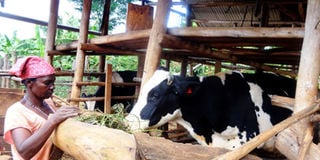How to reap big from zero grazing in cattle

A farmer who practices zero grazing feeding her cows. COURTESY PHOTO
What you need to know:
- Joshua Zimbe, the country manager of East Africa Dairy project (EADP) at Heifer International will share tips on zero grazing at the Monitor Publications Limited ahead of the August 26, farm clinic at Kabanyoro, writes Denis Bbosa.
As land becomes limited especially in urban arrears, zero grazing seems to be the way to go for active and prospective corporate farmers.
Heifer International, whose mission is to work with communities to end world hunger and poverty and to care for the earth, will be partnering with Monitor Publications Limited in the next Seeds of Gold clinic at Naro, Gayaza on August 26 to teach farmers how they can resort to the zero grazing technologies to reap milk in high quantities.
According to Joshua Zimbe, the country manager of East Africa Dairy project (EADP) at Heifer, participants at the clinic will be able to learn of the available market opportunities for their produce, form organised groups and also get to know how to use zero grazing to increase the volumes of milk.
The zero grazing system, that involves feeding cattle with pasture or other food in a confined shade, was given prominence by Heifer back in 1982 when it launched in Uganda.
“Over time as land started becoming a constraint to small scale farmers, we started training farmers to start rearing two or three cows in the zero grazing system so that they can allocate the remaining piece to crop farming.
“This technology system allows the farmers get milk, manure, income and surplus produce to meet the supplement cost,” Zimbe said in an interview on Wednesday.
Beneficiaries
Farming was used as a yardstick by Heifer when introducing the zero grazing technology and it worked out according to Zimbe.
“We have more than 200,000 farmers that have so far embraced the technology and most of them are in semi urban areas where the market is near. That said, we have also introduced the system in Pallisa, Mbale and Gulu districts through the EADP which addresses market and all other concepts across value chain,” Zimbe stressed.
Starting capital
Zimbe hastily says they intend to elaborate more on their three dimension approach to start up a zero grazing venture at the Seeds of Gold clinic; another reason a buzzing farmer should not miss the Shs70, 000 worth workshop.
“Constructing a shade can cost between only Shs2m and Sh3m depending on the size. Most are constructed using locally available materials like wood load and cement but we recommend the usage of grass instead of iron sheets to give the animal a cool environment,” Zimbe states.
Why zero grazing
The benefits are innumerable, Zimbe reveals. The farmers can use manure as fertilisers, get maximum use of a small piece of land (for cattle and farming), get milk for home consumption and sale yet the combination of urine and cow dung creates biogas and organic fertilisers. The residues from the cows can be put back into the cropping system.
Zero grazing requires the cut and carry method of feeding where the recommended Napier grass is fed to the cows to provide proteins. Legumes and other crop residues can also be fed to the animals to get strength. “All the energy reserved from the movement is diverted by the animal to increase milk production.”
Challenges
The ‘hardware disease’, where a cow eats metallic materials from the feeds affects the system most. There is insufficient feeding by the owners due to the financial burden and security risks involved in the zero grazing tend to be high compared to other forms of grazing. Due to space constraints, bulls are not allowed in zero grazing which calls for usage of artificial insemination. In some cases, the cattle attract hoof ailments due to limited movements.
“We have put in place systems to address the above challenges. We also encourage the paddock system (a more intensive management system where land is divided into paddocks by using a fence) because it gives the same quality production,” Zimbe argues, adding that Mbarara Monitor Farm Clinic was an eye opener.
No regrets
Heifer International has no regrets partnering with the Monitor Farm Clinic in Mbarara in May for it sensitised many farmers who are now frequenting their offices on Yusuf Lule Road in Kampala, for advice, animal species, business and a lot more.
“The participants in the August 26 Monitor Farm clinic at Naro, Gayaza should expect a lot in respect of the technology heifer has unveiled recently.
They will learn how they can work in an organised market, embrace the rewarding zero grazing technology, how to improve the feeds and a number of other opportunities and projects because we are the drivers of dairy value chain and we are ready to interface with the farmers,” Zimbe promised.
What you need to know ...
Advantages of zero grazing
1. Livestock cannot get disease easily since their movement is limited.
2. The feeds are utilised well.
3. Many animals can be fed from a very small area.
4. Manure is easily collected since it is in one place.
5. Animals can be observed from close quarters.
6. The animals are more productive.
Disadvantages of zero grazing
1. Diseases can easily spread to animals in the same enclosure because stalls might be too close.
2. It is expensive to start because stalls have to be built.
3. Requires a lot of labour, especially in planting, caring, harvesting and transporting feeds.
4. Due to limited movement, animals do not have the chance to exercise.




